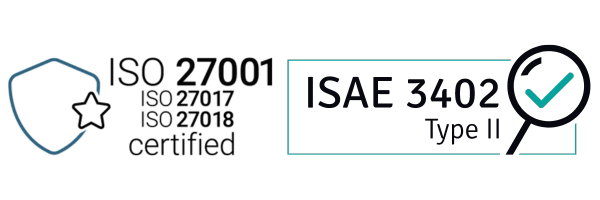
Requirements for global use
The widespread availability of the World Wide Web and the omnipresent use of mobile devices are having a fundamental impact on people’s private lives and their expectations with regard to business transactions. Contractual partners today are usually located in different places. The conclusion of the contract must be quick and feasible, regardless of time and place. Besides improving the customer experience criteria such as greater flexibility, higher efficiency, cost reductions and enhanced legal certainty are the drivers behind the introduction of digital technologies. Signing electronic documents is one of the topics with the greatest source of potential for the digital transformation. Today, e-signature solutions are used around the world and are legally recognised in all industrialised nations.
A signature is a legally binding acknowledgement of the contents of a document. If a dispute arises, it must be clarified who signed and when. For this purpose, people can make use of the signature image, on the one hand, and electronic signatures, on the other. Both together are superior to paper as evidence.
In the European Union (EU), the EU Regulation No. 910/2014, better known as the eIDAS Regulation, provides the legal framework for electronic signatures and trust-based services for electronic commerce in the internal market. The aim of eIDAS is to provide a common basis for secure electronic interactions between citizens, businesses and public authorities, and to increase the efficiency of public and private online services, as well as e-commerce and trade in the EU.
This regulation applies in the same way in all states of the EU. Differences within the EU result from the national law on declarations of intent in different areas of law. Electronic signatures may not be rejected as evidence solely because they are in electronic form. In principle, it can be said that, as long as there is no special legal regulation, declarations can be made in paperless form by means of an e-signature. For reasons of security, it is recommended to use at least one advanced electronic signature (AES).
This regulation applies in the same way in all states of the EU. Differences within the EU result from the national law on declarations of intent in different areas of law. Electronic signatures may not be rejected as evidence solely because they are in electronic form. In principle, it can be said that, as long as there is no special legal regulation, declarations can be made in paperless form by means of an e-signature. For reasons of security, it is recommended to use at least one advanced electronic signature (AES).
In Germany (EU), for example, the German Civil Code (BGB) prescribes the written form (paper) for a few cases. Examples include fixed-term employment contracts and loan agreements. The qualified electronic signature (QES) is equivalent to a handwritten signature on paper. It allows these contracts to be entered into without paper.
However, due to anti-money laundering regulations, identification, which can be done online, is more often required.
Also, in Austria (EU), the written form is required in various cases, which can generally be fulfilled by the qualified electronic signature without paper. In this country, the citizen’s ID card, which contains a qualified electronic signature, is promoted by the state. With the help of a smartphone, a QES can be generated in this way. Identification is possible with an electronic ID card.
Italy (EU) allows for largely paperless declarations. When using an advanced electronic signature (AES), the written form can be replaced in Italy if identification is made by means of an identity document.
Italy’s Codice del’ amministrazione digitale (CAD) is one particular source of irritation in this regard. This was enacted before eIDAS and has not been adapted. With regard to e-signatures, this means that in the non-public (private) sector, eIDAS applies first and in the public sector (state administration), CAD applies in case of any doubt.
Italy’s Codice del’ amministrazione digitale (CAD) is one particular source of irritation in this regard. This was enacted before eIDAS and has not been adapted. With regard to e-signatures, this means that in the non-public (private) sector, eIDAS applies first and in the public sector (state administration), CAD applies in case of any doubt.
In Spain (EU), contracts can, in principle, be concluded without any form, as long as the law does not expressly prescribe otherwise. Here too, the qualified electronic signature can replace the written form.
France (EU) also allows informal declarations of intent to be made on a large scale. In large parts of private law, a simple or advanced electronic signature meets the requirements. In the area of e-administration, a qualified electronic signature is generally required.
In principle, an e-signature is equivalent to a paper signature, provided that the identity and integrity can be guaranteed.
In principle, an e-signature is equivalent to a paper signature, provided that the identity and integrity can be guaranteed.
In 2001, in Poland (EU), electronic signatures were given equal status to handwritten signatures on paper. Since 2018, there has also been an obligation to submit annual financial statements only in electronic form. These can only be made with the qualified electronic signature or the so-called ePUAP signature (electronic platform for public administration services).
Switzerland (EEA) does not impose any formal requirements on declarations of intent in a broad range of areas. With the federal law ZertES, the regulations on electronic signatures of eIDAS were adopted analogously. In addition, the regulated electronic signature was introduced in Switzerland, which should enable companies, in particular, to easily handle paperless processes.
In Liechtenstein (EEA), contracts are not bound by any form. If the written form is required, the signature may be provided by mechanical means insofar as this is customary in business transactions. The eIDAS Regulation has been adopted as directly applicable law in Liechtenstein. The written form may be replaced by a qualified electronic signature.
In the area of money laundering, stricter identification requirements are imposed than in EU countries.
In the area of money laundering, stricter identification requirements are imposed than in EU countries.
The USA offer a heterogeneous picture when it comes to legal issues. This is because each state can enact its own laws. The right associated with declarations of intent is not bound by other legislative constraints. The use of a symbol, e.g. placing a cross under a contract, is considered an action of signing as long as the symbol itself is executed or adopted respectively.
For signatures, the ESIGN Act is of initial relevance. In addition, however, the Uniform Electronic Transactions Act (UETA) must be observed, on the basis of which national regulations can be enacted in addition to the ESIGN Act. ESIGN and UETA are familiar with only one simple electronic signature (SES).
inSign software supports all three signature types according to eIDAS and is currently available in German, English, Spanish, Italian, French, Czech, Polish and Dutch. For any questions, please contact us.

About the author
Christina Detling – Online Marketing Specialist
Christina has been working at inSign for over four years and is happy to pass on her knowledge of electronic signatures and digitisation.
